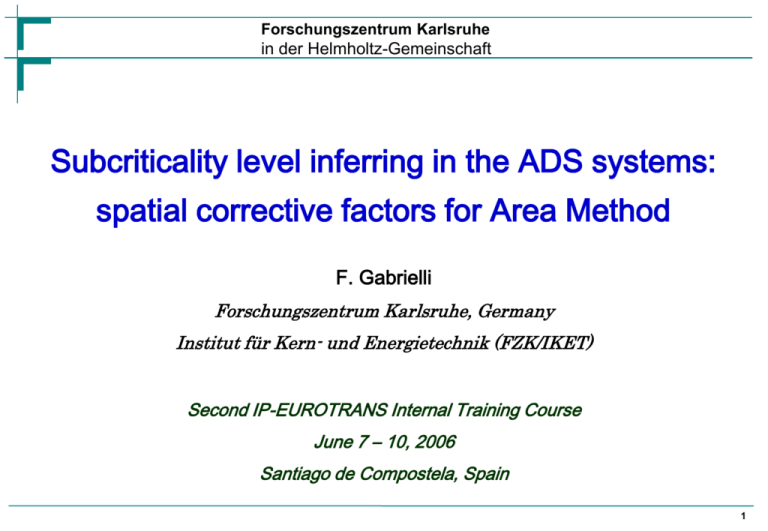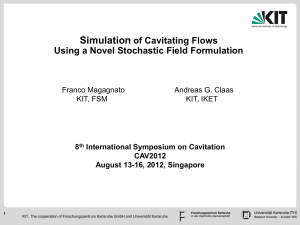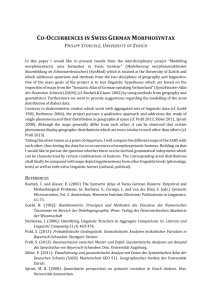spatial corrective factors for Area Method
advertisement

Forschungszentrum Karlsruhe in der Helmholtz-Gemeinschaft Subcriticality level inferring in the ADS systems: spatial corrective factors for Area Method F. Gabrielli Forschungszentrum Karlsruhe, Germany Institut für Kern- und Energietechnik (FZK/IKET) Second IP-EUROTRANS Internal Training Course June 7 – 10, 2006 Santiago de Compostela, Spain 1 Forschungszentrum Karlsruhe in der Helmholtz-Gemeinschaft Layout of the presentation • Principle of Reactivity Measurements • MUSE-4 Experiment • PNS Area Method: a static approach Analysis of the Experimental results: Area method analysis • PNS α-fitting method: L and ap evaluation Analysis of the Experimental results: Slope analysis by α-fitting method • Conclusions 2 Forschungszentrum Karlsruhe in der Helmholtz-Gemeinschaft Principle of Reactivity Measurements Several static/kinetics methods are available to infer the reactivity level of a subcritical system. All these methods are based on the point kinetics assumption, then assuming that: Reactivity does not depend on the detector position, detector type, … Some quantities, i.e. the mean neutron generation time Λ which is used in the slope method, do not depend on the subcritical level. If point kinetics assumptions fail, correction factors are needed. MUSE-4 experiment supplied a lot of information about this subject 3 Forschungszentrum Karlsruhe in der Helmholtz-Gemeinschaft Principle of Reactivity Measurements Depending on the subcriticality level and on the presence of spatial effects, the subcriticality level of the system may not be inferred by the detectors responses in different positions on the basis of a pure point kinetics approach. In this case, corrective spatial factors, evaluated by means of calculations, should be applied to the experimental results analyzed by means of one of the point kinetics based methods, in order to infer the actual subcriticality level of the system. Depending on the used method, corrective factors may have a different amplitude. Thus, from a theoretical point of view, the reliability of a method for inferring the reactivity will be given by the magnitude of the corrective factors to be associated. 4 Forschungszentrum Karlsruhe in der Helmholtz-Gemeinschaft MUSE-4 experiment: layout MUSE (MUltiplication avec Source Externe) program was a series of zero-power experiments carried out at the Cadarache MASURCA facility since 1995 to study the neutronics of ADS . The main goal was investigating several subcritical configurations (keff is included in the interval 0.95-1) driven by an external source at the reactor center by (d,d) and (d,t) reactions, the incident deuterons being provided by the GENEPI deuteron pulsed accelerator. 5 Forschungszentrum Karlsruhe in der Helmholtz-Gemeinschaft MUSE-4 experiment: layout and objectives In particular, the MUSE-4 experimental phase aimed to analyze the system response to neutron pulses provided by GENEPI accelerator (with frequencies from 50 Hz to 4.5 kHz, and less than 1 μs wide), in order to investigate by means of several techniques the possibility to infer the subcritical level of a source driven system, in view of the extrapolation of these methods to an European Transmutation Demonstrator (ETD). 6 Forschungszentrum Karlsruhe in der Helmholtz-Gemeinschaft Experimental techniques analyzed α-fitting method Area method 7 Forschungszentrum Karlsruhe in der Helmholtz-Gemeinschaft PNS Area Method is based on the following relationship relative to the areas subtended by the system responses to a neutron pulse: Ip prompt neutron area eff delayed neutron area Id Concerning the method (which does not invoke the estimate of Λ), it is not possible "a priori" to evaluate the order of magnitude of correction factors even if the system response appears to be different from a point kinetics behaviour. This aspect is strictly connected with the integral nature of the PNS area methods Because of spatial effects, reactivity is function of detector position. These spatial effects can be taken into account by solving inhomogeneous transport timeindependent problems. 8 Forschungszentrum Karlsruhe in der Helmholtz-Gemeinschaft PNS Area Method: a static approach* Neutron source is represented by Q(r,,E,t)=Q(r,,E)δ+(t) and a signal due to prompt neutrons alone is considered The prompt flux p(r,,E,t) satisfies the transport equation 1 Φ p Φ p σΦ p SΦ p p (1-β)FΦ p Q(r,Ω,E) (t) v t With the usual free-surface boundary conditions and the initial condition p(r,,E,t)=0 ∞ ~ Defining the prompt neutron flux Φp(r,Ω,E)=∫Φp(r,Ω,E,t)dt and after integrating over the time… 0 ~ ~ ~ ~ Ω Φ p σΦ p SΦ p χ p (1 β)FΦ p Q(r, Ω, E) Where the initial condition was used and the fact that lim (t) Φp=0 because the reactor is subcritical Therefore, the time integrated prompt-neutron flux satisfies the ordinary timeindipendent transport equation Hence, it can be determined by any of standard multigroup methods [*] S. Glasstone, G. I. Bell, ‘Nuclear Reactor Theory’, Van Nostrand Reinhold Company, 1970 9 Forschungszentrum Karlsruhe in der Helmholtz-Gemeinschaft PNS Area Method: a static approach* ~ Φ p (r, Ω, E) Φ p (r, Ω, E, t)dt ~ ~ ~ 0 ~ Ω Φ p σΦ p SΦ p χ p (1 β)FΦ p Q(r, Ω, E) The time integrated prompt-neutron flux satisfies the ordinary time-independent transport equation ~ The total time-integrated flux Φ(r,Ω,E) satisfies the same equation with χp(1-β) replaced by χ Prompt Neutron Area = ∞ ~ ∫ D(r,t)dt=∫∫∫σd(r,E)ΦpdVdΩdE 0 -ρ($)= Delayed Neutron Area = ~ Prompt Neutron Area Delayed Neutron Area ~ ∫∫∫ σd(Φ - Φp)dVdΩdE [*] S. Glasstone, G. I. Bell, ‘Nuclear Reactor Theory’, Van Nostrand Reinhold Company, 1970 10 Forschungszentrum Karlsruhe in der Helmholtz-Gemeinschaft ERANOS (European Reactor ANalysis Optimized System) calculation description • • • • A XY model of the configurations was assessed The reference reactivity level was tuned via buckling JEF2.2 neutron data library was used in ECCO (European Cell Code) cell code 33 energy groups transport calculations were performed by means of BISTRO core calculation module 11 Forschungszentrum Karlsruhe in der Helmholtz-Gemeinschaft MUSE-4 SC0 1108 Fuel Cells Configuration – DT Source The configuration with 3 SR up, SR 1 down and PR down was analyzed Reference Reactivity: -12.53 $ (Evaluations based on MSA*/MSM+ measurements in a previous configuration) *Modified Source Approximation +Modified Source Multiplication Experimental data from E. González-Romero et al., "Pulsed Neutron Source measurements of kinetic parameters in the source-driven fast subcritical core MASURCA", Proc. of the "International Workshop on P&T and ADS Development", SCK-CEN, Mol, Belgium, October 6-8, 2003. F. Mellier, ‘The MUSE Experiment for the subcritical neutronics validation’, 5th European Framework Program MUSE-4 Deliverable 6, CEA, June 2005. 12 Forschungszentrum Karlsruhe Sc0 results in der Helmholtz-Gemeinschaft MUSE-4 SC0 1108 cells configuration, D-T Source, 3 SR up SR1 down PR down Dispersion means the ratio ρ(MSM)/ ρ(AREA)exp or calc. Reactivity ρ($) Dispersion Detector Experimental [*] Calculated Experimental Calculated (E-C)/C (%) I -14.3 -13.1 0.8762 0.9561 +7.5 L -12.9 -13.0 0.9713 0.9658 -0.6 F -11.9 -11.8 1.0529 1.0603 +0.7 M -12.7 -12.8 0.9866 0.9783 -0.8 G -13.0 -12.4 0.9638 1.0121 +5.0 N -12.1 -11.8 1.0355 1.0587 +2.2 H -12.6 -12.1 0.9944 1.0369 +4.3 A -12.7 -12.4 0.9866 1.0140 +2.8 B -13.0 -12.8 0.9638 0.9824 +1.9 Mean/St.Dev: -12.6 ± 0.4 [*] E. Gonzáles-Romero (ADOPT ’03) 13 Forschungszentrum Karlsruhe in der Helmholtz-Gemeinschaft MUSE-4 SC2 1106 Fuel Cells Configuration – DT Source Reference Reactivity (Rod Drop + MSM): -8.7 ± 0.5 $ 14 Forschungszentrum Karlsruhe SC2 results in der Helmholtz-Gemeinschaft MUSE-4 SC2 1106 cells configuration, D-T Source Dispersion means the ratio ρ(Reference)/ ρ(AREA)exp or calc. Reactivity ρ($) Dispersion Detector Experimental [*] Calculated Experimental Calculated (E-C)/C (%) I -8.6 -8.6 1.012 1.012 0.0 L -8.8 -8.9 0.989 0.978 1.1 F -8.9 -9.0 0.978 0.967 1.1 C -8.7 -8.8 1.000 0.989 1.1 G -9.0 -8.8 0.967 0.989 -2.2 D -8.9 -8.7 0.978 1.000 -2.2 H -8.9 -8.7 0.978 1.000 -2.2 A -8.9 -8.8 0.978 0.989 -1.1 B -9.0 -8.8 0.967 0.989 -2.2 Mean/St.Dev: -8.86 ± 0.16 [*] E. Gonzáles-Romero, ADOPT ‘03 15 Forschungszentrum Karlsruhe in der Helmholtz-Gemeinschaft MUSE-4 SC3 1104 Fuel Cells Configuration – DT Source Reference Reactivity (Rod Drop + MSM): -13.6 ± 0.8 $ 16 Forschungszentrum Karlsruhe SC3 results in der Helmholtz-Gemeinschaft MUSE-4 SC3 972 cells configuration, D-T Source Dispersion means the ratio ρ(Reference)/ ρ(AREA)exp or calc. Reactivity ρ($) Dispersion Detector Experimental [*] Calculated Experimental Calculated (E-C)/C (%) I -12.9 -13.0 1.054 1.046 0.8 L -14.4 -13.8 0.944 0.986 -4.2 F -14.0 -14.0 0.971 0.971 0.0 C -13.7 -13.7 0.993 0.993 0.0 A -13.8 -13.6 0.986 1.000 -1.4 B -13.8 -13.6 0.986 1.000 -1.4 J -12.9 -12.9 1.054 1.054 0.0 K -12.9 -12.8 1.054 1.063 -0.8 Mean/St.Dev: -13.7 ± 0.5 [*] From Y. Rugama 17 Forschungszentrum Karlsruhe in der Helmholtz-Gemeinschaft Experimental results for α-fitting analysis 18 Forschungszentrum Karlsruhe in der Helmholtz-Gemeinschaft PNS α-fitting analysis in MUSE-4 Concerning the PNS α-fitting method (which invokes the evaluation of Λ), three types of possible MUSE-4 responses to a short pulse may be obtained: a) The system responses show the same 1/τ-slope in all the positions (core, reflector and shield), thus the system behaves as a point. b) The system responses show a 1/τ-slope only in some positions, but not all the slopes are equal; the system does not show an ‘integral’ point kinetics behavior and a reactivity value position-depending will be evaluated. Thus, corrective factors have to be applied in order to take into account the reactivity spatial effects. c) The system responses do not show any 1/τ-slopes; the system does not behave anywhere as a point and only experimental data fitting can try to solve the problem. As in the previous case, corrective factors have to be applied. 19 Forschungszentrum Karlsruhe in der Helmholtz-Gemeinschaft Corrective factors approach to the α-fitting analysis When PNS α-fitting method is performed, we assumed that, at least in the prompt time domain, the flux behaves like: (r , E, , t ) e apt (r , E, ) 1.2 1.0 0.8 if we are coherent with this hypothesis, we have to perform the substitution of our factorised flux into: (u.a.) 0.6 0.4 0.2 1 ( t ) (t ) v t 0.0 0 20 40 60 80 100 t ( s) Consequently in the prompt time domain, the (time-constant) shape of the flux obeys the eigenvalue relationship: 20 Forschungszentrum Karlsruhe in der Helmholtz-Gemeinschaft Corrective factors approach to the α-fitting analysis: flow chart “Prompt version” of the inhour equation (ap>>li) αp ρ β eff, d Λd Directly evaluated by the α-eigenvalue equation 21 Forschungszentrum Karlsruhe in der Helmholtz-Gemeinschaft Corrective factors approach to the α-fitting analysis: flow chart It is possible to follow the standard way to calculate αp starting from the k eigenvalue equation: α p,K ρ β eff ΛK 22 Forschungszentrum Karlsruhe in der Helmholtz-Gemeinschaft Prompt α Calculation procedure performed by means of ERANOS ERANOS core calculation transport spatial modules (BISTRO and TGV/VARIANT) solve the k eigenvalue equation: While, for our purpose, the following eigenvalue relationship has to be solved: …that means performing the following substitution if ERANOS is used ap 1 t ins (1 ) p f 0 v K cmod ,z ,g c ,z ,g ap vg K=1 mod z , g (1 z ) p, g 23 Forschungszentrum Karlsruhe in der Helmholtz-Gemeinschaft Prompt α Calculation procedure: MUSE-4 SC0 analysis 1108 Fuel Cells Configuration (3 SR up, SR 1 down and PR down) – DT Source Red data indicate eigenvalues directly evaluated by ERANOS (XY model) k calculation α calculation keff ρ βeff ΛK(ms) αp,k (s-1) 0.95970 -0.04200 0.00335 0.4683 -96821 kd ρ βeff,d Λd(ms) αp (s-1) 0.95843 -0.04337 0.00368 1.0069 -46730 Reactivity values calculated by using φK and ψ eigenfunctions are similar (compensation in the product α· Λ) +47% -48% 24 Forschungszentrum Karlsruhe in der Helmholtz-Gemeinschaft ψ eigenfunctions (α calculation) φk eigenfunctions (k calculation) Spectra in the shielding and in the reflector 2.5E-01 2.5E-01 Reflector Shielding 2.0E-01 Normalized Neutron Spectrum a.u. Normalized Neutron Spectrum a.u. 2.0E-01 1.5E-01 1.0E-01 1.5E-01 1.0E-01 5.0E-02 5.0E-02 0.0E+00 1.E-01 0.0E+00 1.E-01 1.E+00 1.E+01 1.E+02 1.E+03 1.E+04 1.E+05 1.E+06 1.E+07 1.E+08 Energy (eV) 1.E+00 1.E+01 1.E+02 1.E+03 1.E+04 1.E+05 1.E+06 1.E+07 1.E+08 Energy (eV) According to the theory, differences between ψ and φk eigenfunctions energy profiles at low energies are mainly observed in the reflector and in the shielding regions: in fact, besides the different fission spectrum, the main differences will be localized in the spatial and energetic regions where α/v is equal or greater than the Σt term. Such happens at low energies and inside, or near, reflecting regions at low absorption, where the profile of the ψ shapes functions spectra will be more marked than those of the φk functions, because of the lower absorptions. 25 Forschungszentrum Karlsruhe in der Helmholtz-Gemeinschaft Comparison among the calculated results y=exp(α y = exp(alp pt) ha *t) (from alpha eig en va lue calcul ation) 1.E+0 0 K IN3D: Det ect or F (Co re) K IN 3D: Dete ct o r N (Re flect or ) KIN 3D : Det ector A (S hi eld ) MC NP : De tect or F (Co re) 1.E-0 1 MC N P: Detect o r N (Re flector) Arb itrary Un it M CN P : Detec tor A (S hi eld) 1.E-0 2 1.E-0 3 Results seempoint to provide a coherent In any case, kinetics αp slope picture concerning the system 1.E-0 seems to4 agree with exponential 1/τlocation where α-fitting method (with refined evaluation) could slope only inΛthe shield and forbea applied, i.e. far from the source. short1.E-0 time period. 5 0 25 50 75 10 0 12 5 15 0 175 20 0 Ti me (? s) 26 Forschungszentrum Karlsruhe in der Helmholtz-Gemeinschaft MCNP Vs Experimental results MCN P: Detecto r F (C ore ) 1.E +00 M CN P: Det ec tor N (Reflect o r) M CN P: De tector A (Shield) Exp erimen tal: De tector A (Shield ) 1.E-01 Ex perim en tal: Det ector F (Fuel ) Arb it rary Unitt Ex peri m ent al: Det ector N (Refl ect o r) 1.E-02 1.E-03 Experimental Reflector andresults shield show experimental that forslopes large subcriticalities, show a double exponential 1/τ-slopes are behavior different which for 1.E-04 core, is not reproduced reflector and by MCNP shieldcalculations; detectors positions. on the contrary, MCNP results it lookswell evident reproduce a good in the agreement core the for experimental a short time responses. period. 1.E-05 0 25 50 75 1 00 1 25 1 50 1 75 2 00 Tim e ( ? s ) 27 Forschungszentrum Karlsruhe in der Helmholtz-Gemeinschaft Conclusions 1. For large subcriticalities, PNS area method seems to be more reliable respect to a-fitting method, for what concerns the order of magnitude of the spatial correction factors (about 5%). 2. Concerning the application to the ADS situation, because of the beam time structure required for an ADS, it does not allow an on-line subcritical level monitoring, but can be used as “calibration” technique with regards to some selected positions in the system to be analyzed by alternative methods, like Source Jerk/Prompt Jump (which can work also on-line). 3. Codes and data are able to predict the MUSE time-dependent behavior in the core region. The presence of a second exponential behavior in the reflector and shield regions is not evidenced either by the deterministic or by the MCNP simulations. 28 Forschungszentrum Karlsruhe in der Helmholtz-Gemeinschaft THANK YOU FOR YOUR KIND HOSPITALITY Forschungszentrum Karlsruhe in der Helmholtz-Gemeinschaft Prompt α Calculation procedure: pre-analysis 169.6 159 Positions for neutron spectra analysis 148.4 Lead 137.8 Shield 121.9 Reflector NA/SS 66.4 cm, 129.9 cm 116.6 100.7 MOX1 Reflector 95.4 57.5 cm, 92.8 cm 84.8 Radial Shielding 74.2 Core 63.6 17 cm,92.8 cm Axial Shielding Homogenized Beam Pipe 42.4 31.8 MOX3 Z (cm) 21.2 10.6 R (cm) 8.28 18.5 33.1 39.7 55.9 97.03 MUSE-4 Sub-Critical ERANOS RZ model: symmetry axis around the Genepi Beam Pipe axis a1 Forschungszentrum Karlsruhe in der Helmholtz-Gemeinschaft Prompt α Calculation procedure: pre analysis results Red data indicate eigenvalues directly evaluated by ERANOS (RZ model) k calculation α calculation keff ρ βeff ΛK(ms) αp,k (s-1) 0.97124 -0.02961 0.00335 0.51634 -63834 kd ρ βeff,d Λd(ms) αp (s-1) 0.97166 -0.02916 0.00369 0.81633 -40240 +37% -37% a2 Forschungszentrum Karlsruhe in der Helmholtz-Gemeinschaft αp / αp,k Ratio at Different Reactivity Levels 1.2 1 0.8 αp / αp,k αp/αp,k ratio deviates from the unity depending on the subriticality level 0.6 0.4 Far from criticality, the deviation is mainly due to the differences between the mean neutron generation times ΛK and Λd evaluated using respectively φK and ψ eigenfunctions. 0.2 0 0.96 0.97 0.98 0.99 1 1.01 1.02 1.03 keff a3 Forschungszentrum Karlsruhe in der Helmholtz-Gemeinschaft Spectra in the core 2.5E-01 Normalized Neutron Spectrum a.u. 2.0E-01 Core 1.5E-01 ψ eigenfunctions (α calculation) φk eigenfunctions (k calculation) 1.0E-01 5.0E-02 0.0E+00 1.E-01 1.E+00 1.E+01 1.E+02 1.E+03 1.E+04 1.E+05 1.E+06 1.E+07 1.E+08 Energy (eV) a4 Forschungszentrum Karlsruhe in der Helmholtz-Gemeinschaft ψ eigenfunctions (α calculation) φk eigenfunctions (k calculation) Spectra in the shielding and core selected positions 2.5E-01 2.5E-01 Reflector Shielding 2.0E-01 Normalized Neutron Spectrum a.u. Normalized Neutron Spectrum a.u. 2.0E-01 1.5E-01 1.0E-01 1.5E-01 1.0E-01 5.0E-02 5.0E-02 0.0E+00 1.E-01 0.0E+00 1.E-01 1.E+00 1.E+01 1.E+02 1.E+03 1.E+04 1.E+05 1.E+06 1.E+07 1.E+08 Energy (eV) 1.E+00 1.E+01 1.E+02 1.E+03 1.E+04 1.E+05 1.E+06 1.E+07 1.E+08 Energy (eV) According to the theory, differences between ψ and φk eigenfunctions energy profiles at low energies are mainly observed in the reflector and in the shielding regions: in fact, besides the different fission spectrum, the main differences will be localized in the spatial and energetic regions where α/v is equal or greater than the Σt term. Such happens at low energies and inside, or near, reflecting regions at low absorption, where the profile of the ψ shapes functions spectra will be more marked than those of the φk functions, because of the lower absorptions. a5






